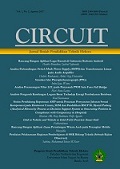Faktor – Faktor yang Mempengaruhi Keberkesanan Amali Kerja Kayu dari Perspektif Pelajar Sekolah Menengah Vokasional di Provinsi Aceh
DOI:
https://doi.org/10.22373/crc.v1i1.1379Keywords:
woodworking practical, workshop environment, workshop facility.Abstract
This study aims to identify factors that influence the effectiveness of practical woodworking and determine the effectiveness of woodworking practical from the perspective of students of secondary vocational schools in the province of Aceh. Factors - factors studied were the workshop equipment, workshop environment. This study was designed to investigate the significant differences concerning factors woodworking practical effectiveness based on demographic factors. A total of 130 respondents were randomly selected from six vocational schools in the province of Aceh. The instrument consists of a set of questionnaire consisting of 49 items and distributed second level students. The results showed there is no significant difference between factors - factors woodworking practical effectiveness based on demographic factors except the income level of the parents and the parents’ workplace. This shows there is a significant effect of the four factors, the effectiveness of practical woodworking, accounting for 60.6% (R2 = 0.606) changes in the variance in effectiveness of hands-on woodworking, and between the two of these factors, the workshop environment is the factor that most influences the effectiveness of the practical work wood, contributing 43.3% (R2 = 0.433) of the variance in effectiveness of woodworking practical.References
Halim Ali, R A S Raja Hassan, Z Zain. Pak Lah Dalam Pendidikan. Malaysia: Penerbit UPSI. 2005
Pavlova. Technology and Vocational Education for Sustainable Development: Empowering Individuals for the future. Griffith University, Australia: Springer. 2009
Direktorat Pembinaan SMK. Data Pokok SMK. Jakarta: Departemen Pendidikan Nasional. 2011.
Billet. Vocational Education: Purposes, Tradition, and Prospect. Griffith University, Australia: Springer. 2009
Peraturan Pemerintah Republik Indonesia, Nombor 29 Tahun 1990.
Ramlee Musthapa. Sekolah Vokasional di Malaysia dan Sekolah Kejuruan di Indonesia. Seminar Educational Comparative in Competency Based Curriculum Between Indonesia and Malaysia. Prosiding. Indonesia University of Education, University Kebangsaan Malaysia dan Universiti Malaya: Bandung. 2012
Berita dalam akhbar Serambi Indonesia. Banda Acheh: 17 Februari 2013.
Siti Atiqah B. Sharudin. Faktor yang Mempengaruhi Keberkesanan Pengajaran dan Pembelajaran di Dalam Bengkel Vokasional di Dua Buah Sekolah Menengah Teknik di Negeri Sembilan. Universiti Teknologi Malaysia: Tesis Sarjana Muda. 2008.
Ramlee Musthapa. Sejarah Pendidikan kejuruan di Nusantara: Pembangunan Identiti Negara-Bangsa serta Modal Insan di Malaysia dan Indonesia. Jurnal Kajian Sejarah & Pendidikan Sejarah, No.1, Vol.1, Maret 2013.
Sugiyono. Upaya peningkatan Ketrampilan Pelajar membuat Ukiran Kayu pada Kelas X semester 2 SMK Negeri Lhokseumawe. Dalam Prosiding Seminar Nasional Yusuf Benseh. Politeknik Negeri Lhokseumawe: Indonesia. 2013.
S S Mok. Pendidikan di Malaysia. Kuala Lumpur. Kumpulan Budiman Sdn. Bhd. 2000
S Atiqah B. Sharudin. Faktor yang Mempengaruhi Keberkesanan Pengajaran dan Pembelajaran di Dalam Bengkel Vokasional di Dua Buah Sekolah Menengah Teknik di Negeri Sembilan. Universiti Teknologi Malaysia: Tesis Sarjana Muda. 2008.
Azizi Yahaya, Wong. Keberkesanan Proses Pengajaran di Kalangan Guru Kejuruteraan Awam di Sekolah Menengah Teknik. Isu-isu Pendidikan Teknikal Vokasional, Skudai: Penerbit UTM. 2007.
Teddlie C D, Reynolds. The International Handbook of School Effectiveness Research. Falmer Press, Taylor&Francis Group: London & Newyork. 2000.
Irmayanti I. Kesediaan Pelajar Dalam Pelaksanaan Amali KejuruteraanAwam Di Politeknik. Universiti Tun Hussein Onn Malaysia: Tesis Sarjana. 2008.
Rizal Muhammad. Mohd Said dan R. Zahari. Kajian Aplikasi Ergonomik Terhadap Pelajar Ketika Melakukan Kerja-Kerja Amali Bengkel Di Kalangan pelajar-Pelajar 4 SPH PKPG Fakulti Pendidikan UTM. Journal of Technical, Vocational & Engineering Educational. Volume 3 September 2011, Pages 116-131/ISSN: 2231-7376.
K A Khan, D J Vickery. “The Design of Workshop For Asian Second Level Schoolsâ€. Colombo Unesco. 1970.
Ramlee Mustapha, S Vengidason, N Azlina Hasbullah, R A. Bahtiar, R C. Rus. Reka Bentuk Penyelidikan. Dalam M.Nor Azhari Azman, Ramlee Mustapha. Pendidikan Teknikal & Vokasional: Pendekatan Penyelidikan, Analisis & Interpretasi.(pp. 40-86). Tanjong Malim, Perak, Malaysia : Penerbit universiti pendidikan sultan idris. 2015.
Creswell J W. Educational Research: Planning, Conducting, and Evaluating Quantitative and Qualitative Research (Second ed). New Jersey, USA : Pearson-Merril Prentice Hall. 2002.
Kelley K. B Clark, B. Brown. Methodology Matters: Good Practice in The Conduct and Reporting of Survey Research dalam International Journal for Quality in Health Care, 15(3), hlm.261 – 266, 2003.
Downloads
Published
Issue
Section
License
Authors who publish in CIRCUIT: Jurnal Ilmiah Pendidikan Teknik Elektro agree to the following terms:
- Authors retain copyright and grant the journal right of first publication with the work licensed under a Creative Commons Attribution-ShareAlike 4.0 International License (CC BY-SA 4.0) that allows others to share and adapt the work with an acknowledgement of the authorship and initial publication in this journal
- Authors are able to enter into separate, additional contractual arrangements for the non-exclusive distribution of the journal's published version of the work (e.g., post it to an institutional repository or publish it in a book), with an acknowledgment of its initial publication in this journal.
- Authors are permitted and encouraged to post their work online (e.g., in institutional repositories or on their website) prior to and during the submission process, as it can lead to productive exchanges, as well as earlier and greater citation of published work. (See The Effect of Open Acces)

